There is
much discussion over whether or not the "spoked-wheel" design is
documentable. Here is some support for this design.
It is true that we currently have no clear, positive proof of
the *design* of the inner structure, we have obvious clear proof (by inference)
of some sort of interior structure. Now, why do I say this? Well, for
several reasons. Look at the examples below:
|
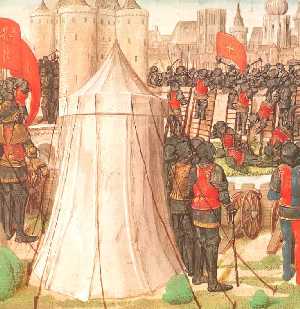
|
|
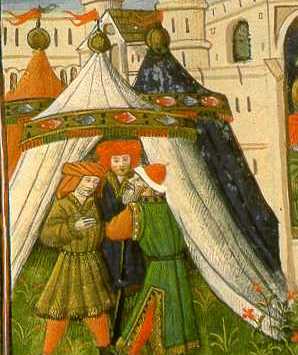
|
|
A tent clearly showing a multi-sectional
structure (not exactly round), with the shape not provided by the
ropes.
|
|
A tent with lines that perhaps indicate the tent
was not truly round, but sectional. Clearly no ropes.
15th century (Die Mahlzeit des König Artus,
from Livre de Messire, Lancelot du Lac)
|
1) Many period
paintings have NO ropes on the tents, even by people who put ropes on the tents
in many of their paintings. Look at the paintings of Jean Froissart, Chronicles
in the Bibliothèque Nationale de France (BNF), http://www.bnf.fr/enluminures/aaccueil.htm.
Many of these have ropes and many do not. In particular, look at the following
images, and click on the thumbnails for the larger image.:
| - Charles of Blois, duke of Brittany, besieging Hennebont (1342). (BNF, FR
2643)
In the Hennebont painting, the red tent in the background appears to ropes
(look at the right most crow's foot, it appears to be going off the edge), yet
the white tent seems to definitely NOT have ropes. How would it have this shape
without some interior structure?
|
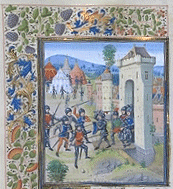
|
| - Charles of Blois, duke of Brittany, is taken prisoner at the Battle of La
Roche-Derrien (1347). (BNF, FR 2643)
I am interested in the explanation for the tent that is collapsing in this
painting. How could it possibly be collapsing as indicated and
still retain that conical top if it did not have *some kind* of interior
structure?
|
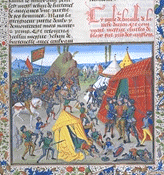
|
| - Edward III of England besieging Reims (1359/60) (BNF, FR 2643)
In the Edward III picture, there is no way the tent in the foreground could
have the shape and structure using only the ropes and angles indicated.
|
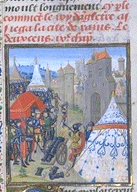
|
| - Battle of Cassel: the French combat the Flemish (1328). (BNF, FR 2643)
The front tent in the Cassel picture is similar. We can see "into"
the tent but there are no perimeter poles, and the ropes indicated would not
give it that shape and structure.
|
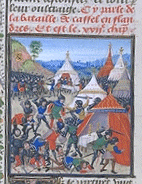
|
2) There are two pictures below. One from the Cloth of
the Field of Gold and one from a German woodcut from 1520.
In the Cloth of Gold, there are ropes and they clearly do not support the
structure. You can see the center pole and stuff inside, but clearly no perimeter
poles. How does the tent keep this shape? In the German woodcut, some of the
tents have ropes, but others don't. How do they keep their shape?
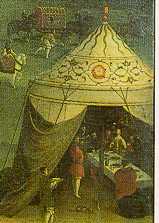 |
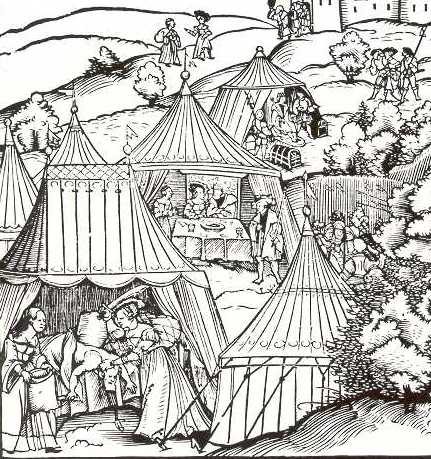 |
| From the Field of the Cloth of Gold.
Clearly showing the center pole and the ropes, indicating that the shape
of the tent is not because of the ropes. |
A German woodcut from 1520. Clearly some
tents with ropes
and some without. How do those without keep their
shape?
|
Here is a drawing of a tournament camp from 1360. NONE of those tents show ropes...
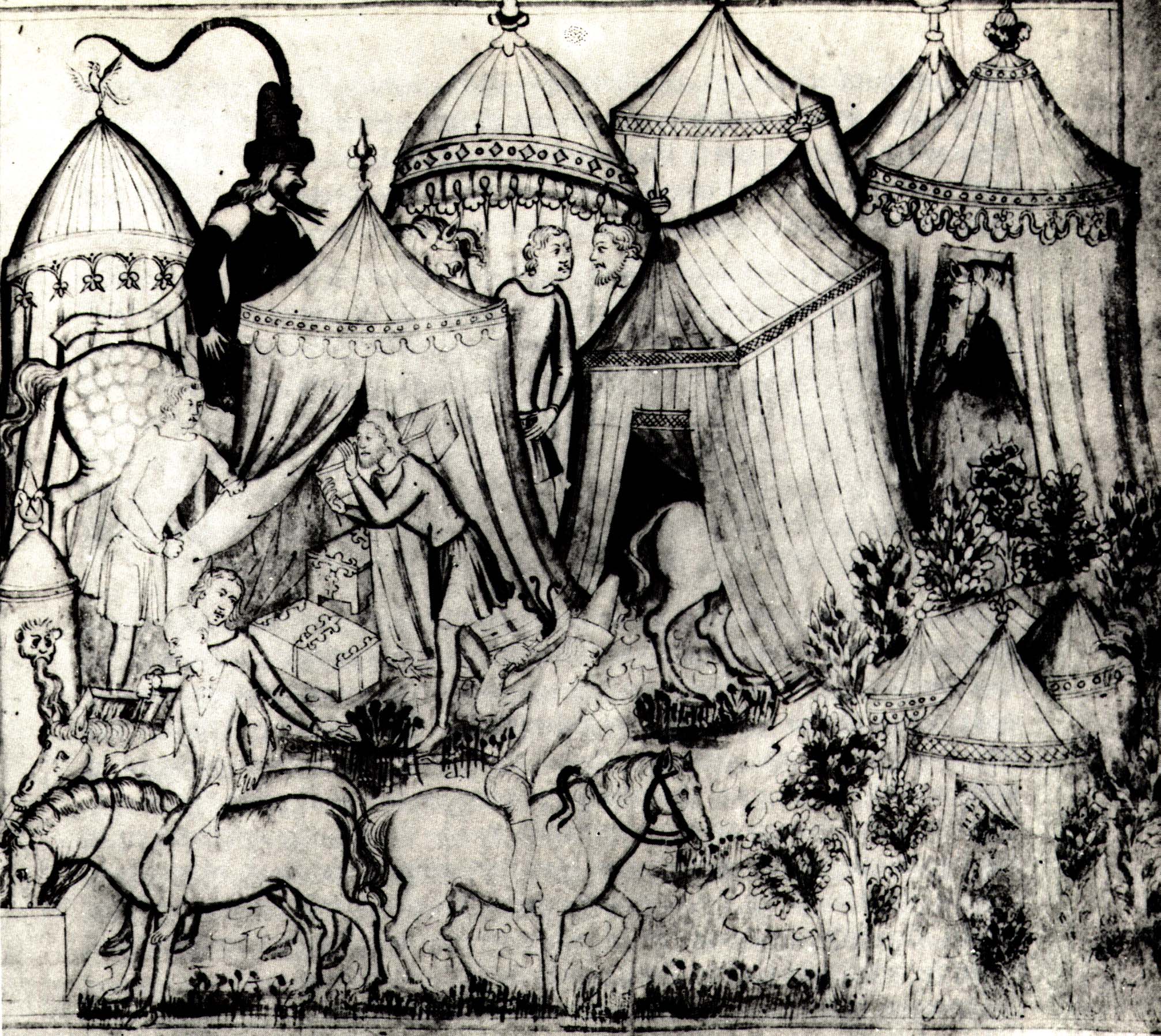 |
|
A camp before a tournament, c. 1360.
British Library.
|
Here is a 14th century French painting from the Bibliotheque Nationale in Paris.
This one shows a lot of shape and structure but no
indications of perimeter poles or ropes.
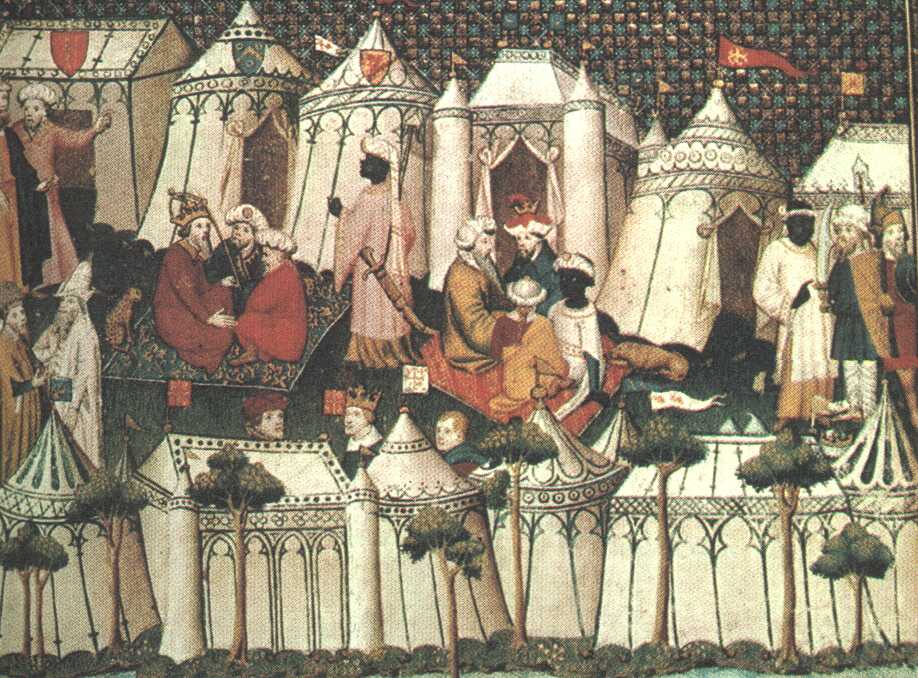 |
|
Negotiations in tents, French, 14th century,
Paris, Bibliotheque Nationale |
3) Looking again at the BNF
|
- Genoese besieging Mahdia, in Tunisia (1390) (BNF, FR 2646)
NONE of them show ropes nor any indication of perimeter poles, yet they maintain their shape
and structure somehow.
|
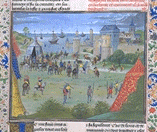
|
| - Massacre of the Christian prisoners taken an the Battle of Nicopol, in the presence of the Ottoman Sultan Bayezid I. (BNF, FR 2646)
Again no ropes or perimeter poles.
|
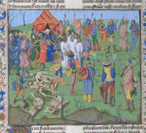
|
4) Look at the Dream of Constatine, by Piero della Francesco, c. 1455, and
see the center pole, without any perimeter poles or ropes.
5) Look at the Tent of Hope, in King Renee's Book of Love, 1457. You can
clearly see ropes, and it may be that these truly do hold the tent out at the
correct shape and angle, however it also appears that you can see through to the
inside with no appearance of perimeter poles.
| However, other round tents in King
Renee's book, like the round tent in the "Honour's Tent" painting
could not have that shape with just the ropes. |
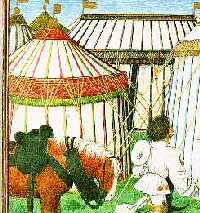 |
All these pictures show that while I cannot prove what DESIGN the interior structure used,
it is pretty evident that that they had *some sort* of interior
structure. It may have been a wagon wheel, as some have suggested, but then a
wagon wheel is really just a hub and spoke design. It is difficult for me to believe that wagon
wheels were routinely used, because there were some awfully large tents, and I
have seen no evidence for wheels that were 12 feet (or even 8 feet) in diameter
like the hubs and spokes in my two pavilinos (or any of the tens in these
images)...
Return to pavilion page.












